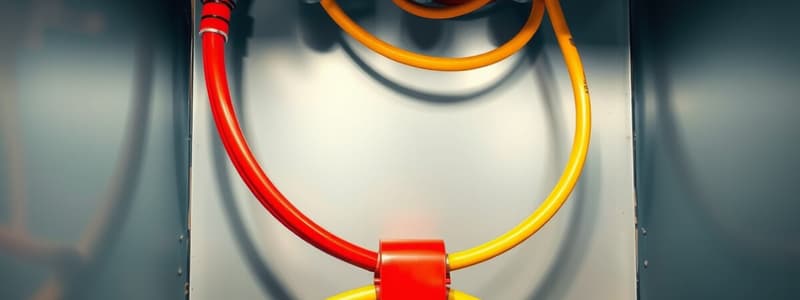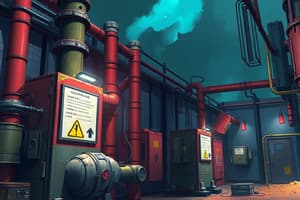Podcast
Questions and Answers
Explosionproof equipment and wiring shall be required in Class II locations.
Explosionproof equipment and wiring shall be required in Class II locations.
False (B)
What is required for flexible connections to elevators in Class II, Division 1 locations?
What is required for flexible connections to elevators in Class II, Division 1 locations?
listed dusttight fittings
What type of boxes and fittings are required in Class II, Division 1 locations?
What type of boxes and fittings are required in Class II, Division 1 locations?
dusttight
Type TC-ER cable installed in a Class II, Division 2 location must include a bonding jumper.
Type TC-ER cable installed in a Class II, Division 2 location must include a bonding jumper.
Nonincendive field wiring is permitted using any of the wiring methods for what type of locations?
Nonincendive field wiring is permitted using any of the wiring methods for what type of locations?
What is the required space between adjacent cables installed in ladder trays?
What is the required space between adjacent cables installed in ladder trays?
What is the minimum length for a vertical raceway extending from a dust-ignitionproof enclosure?
What is the minimum length for a vertical raceway extending from a dust-ignitionproof enclosure?
Surge-protective capacitors must be of a type designed for what?
Surge-protective capacitors must be of a type designed for what?
What is required on fire doors communicating with Class II, Division 1 locations to minimize dust entrance?
What is required on fire doors communicating with Class II, Division 1 locations to minimize dust entrance?
Transformers that do not contain a liquid that will burn shall be installed in vaults.
Transformers that do not contain a liquid that will burn shall be installed in vaults.
Transformers and capacitors are permitted in a Class II, Division 1, Group E location if enclosed in a vault.
Transformers and capacitors are permitted in a Class II, Division 1, Group E location if enclosed in a vault.
What type of enclosures are required for devices in Class II, Division 1 locations?
What type of enclosures are required for devices in Class II, Division 1 locations?
What types of motors are allowed in Class II, Division 1 locations?
What types of motors are allowed in Class II, Division 1 locations?
What is the minimum thickness required for ventilating pipes in Class II, Division 1 locations?
What is the minimum thickness required for ventilating pipes in Class II, Division 1 locations?
What type of flexible cord is permitted in Class II, Division 1 locations?
What type of flexible cord is permitted in Class II, Division 1 locations?
Each luminaire in Class II, Division 1 locations must indicate what for the lamp?
Each luminaire in Class II, Division 1 locations must indicate what for the lamp?
Ventilating pipes in Class II, Division 1 locations must be what throughout their length?
Ventilating pipes in Class II, Division 1 locations must be what throughout their length?
What is the minimum airspace required for transformers rated in excess of 25 kVA?
What is the minimum airspace required for transformers rated in excess of 25 kVA?
Flashcards are hidden until you start studying
Study Notes
Explosionproof Equipment in Class II Locations
- Explosionproof equipment is not required or acceptable in Class II locations unless specifically identified.
Wiring Methods for Class II, Division 1
- Permitted wiring methods in Class II, Division 1 locations include:
- Threaded rigid metal conduit
- Threaded steel intermediate metal conduit
- Type MI cable
Elevator Cable Requirements
- Elevator cable types EO, ETP, or ETT are allowed in Class II, Division 1 locations only when terminated with listed dusttight fittings.
Boxes and Fittings Specifications
- Boxes and fittings in Class II, Division 1 must have threaded bosses for conduit or cable and be dusttight.
Type TC-ER Cable Requirement
- Type TC-ER cable in Class II, Division 2 does not require a bonding jumper in addition to any existing drain wire.
Nonincendive Wiring
- Nonincendive field wiring is permitted using wiring methods suitable for unclassified locations.
Cable Installation in Trays
- Type P cable must be installed in a single layer in cable trays with a minimum space equal to the larger cable diameter unless protected against dust buildup.
Raceway Sealing Standards
- A vertical raceway, at least 5 feet long, extending downward from a dust-ignitionproof enclosure is an approved sealing method in Class II locations.
Surge-Protective Capacitors
- Surge-protective capacitors must be designed for their specific duty.
Transformer and Capacitor Vault Requirements
- Transformers and capacitors with burning liquids in a vault need self-closing fire doors that have suitable seals to limit dust entrance.
Non-Flammable Transformers and Capacitors
- Transformers and capacitors without burning liquids must be either installed in compliant vaults or identified as a complete assembly including terminal connections.
Installation Restrictions for Transformers in Class II Locations
- Transformers and capacitors must not be installed in Class II, Division 1, Group E locations unless enclosed in a vault.
Device Enclosure Specifications
- Enclosures for switches, circuit breakers, motor controllers, etc., in Class II, Division 1 must not be of any specific type for that location.
Electrical Machinery Requirements
- Motors, generators, and other electrical machinery must be labeled as Class B or C for Class II, Division 1 locations.
Ventilating Pipes Standards
- Ventilating pipes for motors or electrical equipment must be made of metal at least 0.021 inches thick or otherwise be noncombustible.
Wiring for Pendant Luminaires
- In Class II, Division 1 locations, wiring between outlet boxes and pendant luminaires not enclosed in conduit must be flexible cord listed for hard use.
Luminaire Identification
- Each luminaire must be identified for Class II, Division 1 locations and clearly marked for the type and maximum wattage of the lamp.
Dusttight Ventilating Pipes
- Ventilating pipes and their connections in Class II, Division 1 locations must be dusttight along their entire length.
Transformers with Askarel Requirements
- Transformers over 25 kVA containing askarel in Class II, Division 2 must have a minimum of 6 inches of airspace from combustible materials.
Studying That Suits You
Use AI to generate personalized quizzes and flashcards to suit your learning preferences.



